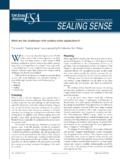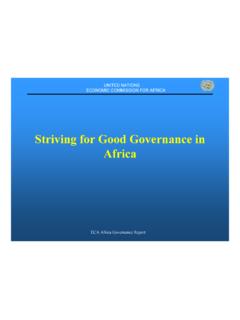Transcription of Big Data for Development: Challenges & Opportunities
1 big data for Development: Challenges & Opportunities May 2012 2 Acknowledgements This paper was developed by UN Global Pulse, an initiative based in the Executive Office of the Secretary-General United Nations. Global Pulse is grateful to the Government of Australia, Government of Sweden, the Government of the United Kingdom, UNDP, UNICEF, WFP and the UN s Department of Public Information to their generous support to the initiative. The paper was written by Emmanuel Letouz , Senior Development Economist (2011), with research support from current and former Global Pulse colleagues who provided resources, feedback and helped shape the ideas that inform the contents of this paper. It was edited by Anoush Rima Tatevossian and Robert Kirkpatrick, with copyediting support from Cassandra Hendricks.
2 The production and design of the report was supported by Charlotte Friedman. We would like to thank Scott Gaul, Bj rn Gills ter, and Samuel Mendelson, for their time in reviewing a number of draft versions of this paper, and providing detailed feedback. Global Pulse has benefited from the experience and expertise of a wide range of colleagues both inside and outside of the UN system. Global Pulse acknowledges the extensive research conducted in this diverse and emerging field by partners such as the Billion Prices Project, JANA, Ushahidi, International Food Policy Research Institute (IFPRI), Google Flu Trends, the Global Viral Forecasting Initiative, Telefonica Research, the Institute for Quantitative Social Science at Harvard University, L'institut des Syst mes Complexes Paris le-de-France, SAS, Crimson Hexagon, and UNICEF.
3 The report is available online at The analysis and recommendations of this paper do not necessarily reflect the views of the United Nations, or the Member States the United Nations. The views presented in this report are the sole responsibility of its authors. To provide feedback, comments or for general inquiries, please contact: Global Pulse 370 Lexington Ave, Suite 1707 New York, New York 10017 E-mail: Web: COVER ART: A visualization representing global Google search volume by language. Developed by the Google data Arts Team. 3 About Global Pulse: Global Pulse is a United Nations initiative, launched by the Secretary-General in 2009, to leverage innovations in digital data , rapid data collection and analysis to help decision-makers gain a real-time understanding of how crises impact vulnerable populations.
4 Global Pulse functions as an innovation lab, bringing together expertise from inside and outside the UN to harness today s new world of digital data and real-time analytics for global development. The initiative contributes to a future in which access to better information sooner makes it possible to keep international development on track, protect the world s most vulnerable populations, and strengthen resilience to global shocks. To this end, Global Pulse is pursuing a three-fold strategy that consists of 1) researching innovative methods and techniques for analysing real-time digital data to detect early emerging vulnerabilities; 2) assembling free and open source technology toolkit for analyzing real-time data and sharing hypotheses; and 3) establishing an integrated, global network of Pulse Labs, anchored in Pulse Lab New York, to pilot the approach at country level.
5 For more information please visit 4 Abstract Innovations in technology and greater affordability of digital devices have presided over today s Age of big data , an umbrella term for the explosion in the quantity and diversity of high frequency digital data . These data hold the potential as yet largely untapped to allow decision makers to track development progress, improve social protection, and understand where existing policies and programmes require adjustment. Turning big data call logs, mobile-banking transactions, online user-generated content such as blog posts and Tweets, online searches, satellite images, etc. into actionable information requires using computational techniques to unveil trends and patterns within and between these extremely large socioeconomic datasets.
6 New insights gleaned from such data mining should complement official statistics, survey data , and information generated by Early Warning Systems, adding depth and nuances on human behaviours and experiences and doing so in real time, thereby narrowing both information and time gaps. With the promise come questions about the analytical value and thus policy relevance of this data including concerns over the relevance of the data in developing country contexts, its representativeness, its reliability as well as the overarching privacy issues of utilising personal data . This paper does not offer a grand theory of technology-driven social change in the big data era.
7 Rather it aims to delineate the main concerns and Challenges raised by big data for Development as concretely and openly as possible, and to suggest ways to address at least a few aspects of each. It is important to recognise that big data and real-time analytics are no modern panacea for age-old development Challenges . That said, the diffusion of data science to the realm of international development nevertheless constitutes a genuine opportunity to bring powerful new tools to the fight against poverty, hunger and disease. 5 Table of Contents INTRODUCTION .. 6 SECTION 1: OPPORTUNITY .. 8 data INTENT AND CAPACITY .. 8 The data Revolution .. 8 Relevance to the Developing World.
8 9 Intent in an Age of Growing Volatility .. 11 big data for Development: Getting Started .. 13 Capacity: big data Analytics .. 17 SOCIAL SCIENCE AND POLICY APPLICATIONS .. 19 A Growing Body of Evidence .. 20 SECTION II: Challenges .. 24 data .. 24 Privacy .. 24 Access and Sharing .. 25 ANALYSIS .. 26 Getting the Picture Right .. 27 Interpreting data .. 29 Defining and Detecting Anomalies in Human Ecosystems .. 33 SECTION III: APPLICATION .. 35 WHAT NEW data STREAMS BRING TO THE TABLE .. 35 Know Your data .. 35 Applications of big data for Development .. 36 MAKING big data WORK FOR DEVELOPMENT .. 39 Contextualisation is Key .. 39 Becoming Sophisticated Users of Information .. 40 CONCLUDING REMARKS ON THE FUTURE OF big data FOR DEVELOPMENT.
9 42 6 Introduction Since the turn of the century, innovations in technology and greater affordability of digital devices have presided over the Industrial Revolution of data , 1 characterised by an explosion in the quantity and diversity of real-timei digital data resulting from the ever-increasing role of technology in our lives. As a result, we are entering an unprecedented period in history in terms of our ability to learn about human behaviour. 2 What was a hypothesis only a few years ago is today being confirmed by researchers and corporations, and has recently received significant coverage in the mainstream media3: analysis of this new wealth of digital data the massive and ever-expanding archive of what we say and do using digital devices every day may reveal remarkable insights into the collective behaviour of communities.
10 No less significantly, just as this data is generated by people in real time, so it may now be analysed in real time by high performance computing networks, thus creating at least the potential for improved decision-making. It is time for the development community and policymakers around the world to recognise and seize this historical opportunity to address twenty-first century Challenges , including the effects of global volatility, climate change, and demographic shifts, with twenty-first century tools. What exactly is the potential applicability of big data for Development? At the most general level, properly analysed, these new data can provide snapshots of the well-being of populations at high frequency, high degrees of granularity, and from a wide range of angles, narrowing both time and knowledge gaps.







